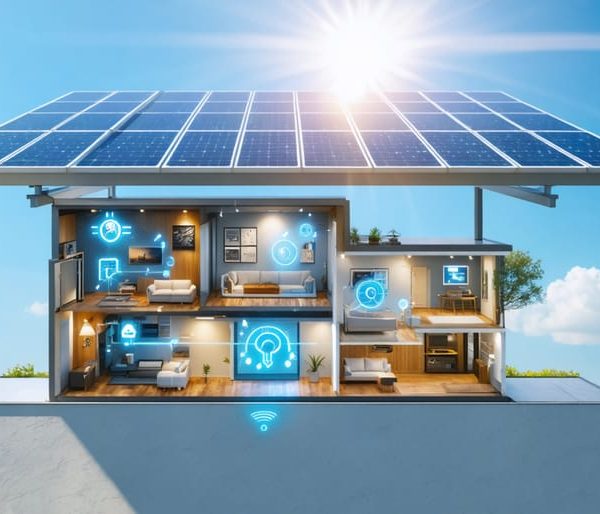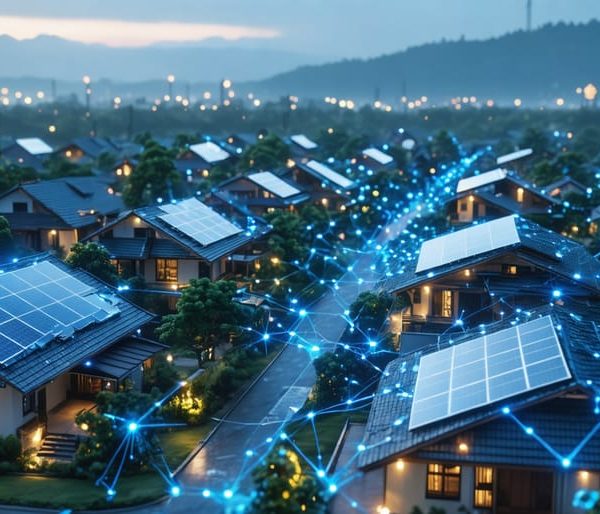
Solar-Powered Cleaning Equipment That Slashes Your Commercial Energy Costs
Transform your commercial cleaning operations with the future of sustainable maintenance by using innovative commercial cleaning equipment powered by solar energy. These innovative solutions harness the sun’s endless energy to power everything from autonomous floor scrubbers to high-pressure washers, slashing electricity costs while maintaining pristine facilities.
Today’s solar cleaning technology combines advanced photovoltaic cells with efficient energy storage systems, enabling consistent performance even during cloudy days or night shifts. For facility managers and business owners, this represents a dual opportunity: significant reduction in operational expenses and a powerful demonstration of environmental leadership that resonates with increasingly eco-conscious customers.
The latest generation of solar-powered cleaning equipment delivers professional-grade performance while eliminating the constraints of power cords and reducing carbon emissions. From compact handheld devices to industrial-scale cleaning machines, these sustainable solutions are revolutionizing how we approach commercial cleaning – proving that environmental responsibility and operational efficiency can work hand in hand.
Choose solar-powered cleaning equipment to position your business at the forefront of sustainable facility management while enjoying substantial long-term cost savings.
How Solar-Powered Cleaning Equipment Works
Solar Panel Integration
Modern cleaning equipment integrates solar power through strategically placed photovoltaic panels that capture and convert sunlight into usable electricity. These panels are typically mounted on the equipment’s upper surfaces, maximizing sun exposure while maintaining the device’s functionality. A smart charge controller manages the power flow, ensuring optimal battery charging and equipment performance.
The integration process includes three key components: solar panels, power storage systems, and energy-efficient motors. High-efficiency solar cells, often made from monocrystalline silicon, are protected by durable, weather-resistant casings. The stored energy powers both the cleaning mechanisms and automated features, with advanced solar panel monitoring systems ensuring consistent performance.
Most units feature plug-and-play designs, making installation straightforward for both residential and commercial users. The panels connect directly to built-in batteries, which store excess energy for use during cloudy days or nighttime operation. Smart power management systems automatically adjust energy consumption based on cleaning requirements, ensuring optimal efficiency while extending battery life.
This seamless integration of solar technology makes these cleaning devices both environmentally friendly and cost-effective, with minimal maintenance requirements.
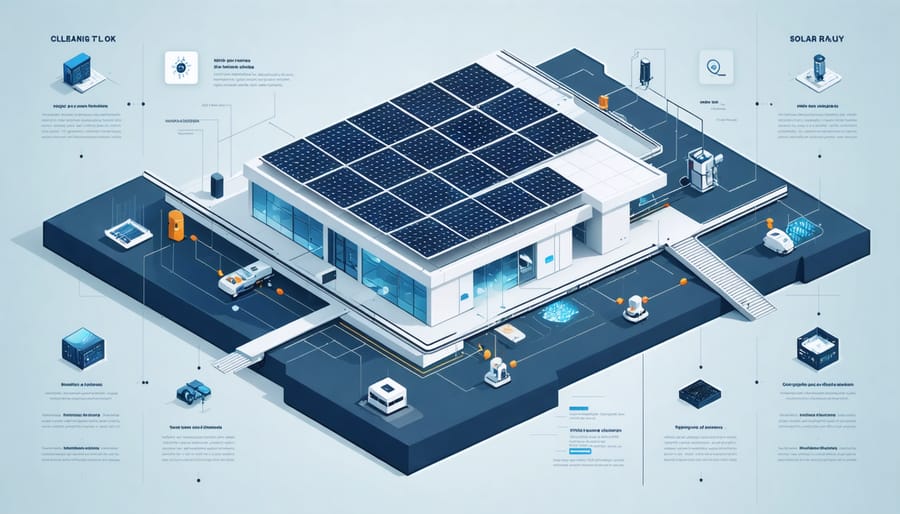
Battery Storage Systems
Battery storage systems are the backbone of reliable solar-powered cleaning equipment, ensuring consistent performance even when the sun isn’t shining. These systems typically use advanced lithium-ion batteries, which store excess energy generated during peak sunlight hours for later use.
Modern storage solutions come with smart power management features that automatically regulate energy flow, protecting your equipment from power surges while maximizing battery life. Most systems include monitoring displays that show real-time battery levels, helping operators plan their cleaning schedules effectively.
For optimal performance, many battery systems now incorporate dual-charging capabilities, allowing them to charge from both solar panels and conventional power sources when needed. This hybrid approach ensures your cleaning equipment remains operational during extended periods of cloudy weather or overnight cleaning sessions.
When selecting a battery storage system, consider your specific needs: A small residential setup might only require a 2-4 kWh battery, while commercial operations typically need 10+ kWh systems to power multiple pieces of equipment. Many manufacturers now offer modular solutions, allowing you to expand your storage capacity as your needs grow.
Popular Solar-Powered Cleaning Solutions
Floor Cleaning Machines
Solar-powered floor cleaning machines are revolutionizing the way we maintain our spaces, offering eco-friendly commercial cleaning solutions that significantly reduce energy costs. These innovative devices harness solar energy through integrated panels or dedicated charging stations, providing sustainable cleaning power for both homes and businesses.
Modern solar vacuum cleaners feature high-efficiency motors and smart sensors that optimize power consumption while maintaining powerful suction. Many models include dual-charging capabilities, allowing them to store energy from both solar panels and traditional power sources for uninterrupted operation during cloudy days or nighttime cleaning sessions.
Solar-powered floor scrubbers represent another breakthrough in sustainable cleaning technology. These machines combine water-efficient cleaning mechanisms with solar-powered drive systems, making them ideal for large commercial spaces like malls, airports, and warehouses. Users report up to 70% reduction in energy costs compared to traditional electric scrubbers.
The latest models come equipped with advanced features like automated route planning, adjustable cleaning modes, and remote monitoring capabilities. Most importantly, these machines pay for themselves through energy savings within two to three years of operation, while significantly reducing your carbon footprint. Many businesses are finding that investing in solar-powered floor cleaning equipment not only supports their sustainability goals but also provides substantial long-term cost benefits.
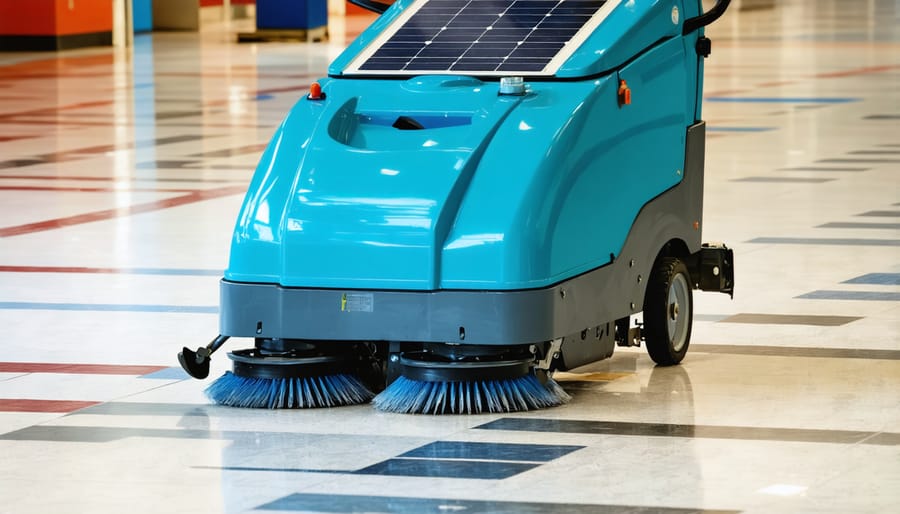
Pressure Washers
Solar-powered pressure washers represent a significant advancement in eco-friendly cleaning technology. These innovative systems combine traditional pressure washing capabilities with solar panels and energy storage solutions, allowing for powerful cleaning without relying on grid electricity or fossil fuels.
Most solar pressure washing systems consist of photovoltaic panels connected to a battery bank, which powers an electric motor driving the pressure pump. The stored energy ensures consistent operation even on cloudy days or during evening hours. Some models include hybrid capabilities, allowing them to switch to grid power when needed.
These systems typically deliver pressures between 1500-3000 PSI, making them suitable for various cleaning tasks from residential driveways to commercial building exteriors. The initial investment in solar-powered pressure washers is offset by significant long-term savings on energy costs and reduced maintenance requirements.
Users report particular satisfaction with the mobility these units offer, as they can operate anywhere without needing access to power outlets. This makes them ideal for remote locations or large properties where traditional electric pressure washers would be impractical. Additionally, the quiet operation and zero emissions make them perfect for noise-sensitive environments and areas with strict environmental regulations.
Portable Cleaning Tools
Portable solar-powered cleaning tools are revolutionizing the way we approach everyday cleaning tasks. These compact devices harness solar energy through built-in panels or detachable solar chargers, making them perfect for both indoor and outdoor use. From handheld vacuum cleaners to compact pressure washers, these tools combine convenience with eco-friendly operation.
Popular options include solar-charged window cleaners that use ultrasonic technology to break down dirt, and portable steam cleaners that can run for up to two hours on a single solar charge. These devices typically feature lightweight designs and ergonomic handles for comfortable use, while their rechargeable batteries can store excess solar power for cloudy days.
Many models come with dual-charging capabilities, allowing you to charge via solar panels or traditional power outlets when needed. The latest innovations include smart features like battery level indicators and automatic power adjustment based on the cleaning task. While these tools may have a higher upfront cost compared to conventional alternatives, users report significant savings on electricity bills and appreciate the freedom of cordless operation.
For maximum efficiency, look for models with high-capacity batteries and quick-charging capabilities. Most portable solar cleaners can fully charge within 4-6 hours of direct sunlight, making them reliable tools for daily cleaning tasks.
Cost Benefits and ROI
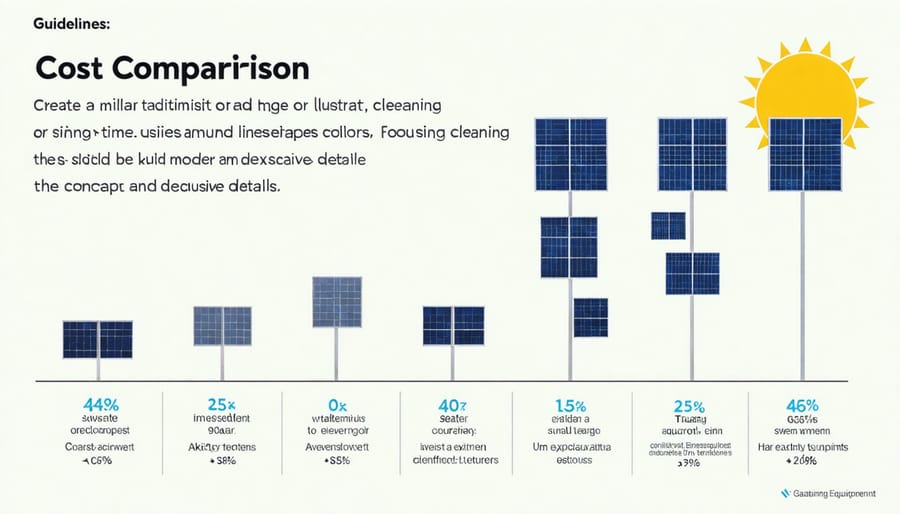
Energy Savings Calculator
To calculate potential savings from switching to solar-powered cleaning equipment, start by listing your current equipment’s power consumption in kilowatt-hours (kWh). Multiply this by your local electricity rate to determine your current monthly energy costs. Next, factor in the average daily sunlight hours in your area and the efficiency rating of solar-powered alternatives.
For example, if your traditional pressure washer uses 1.5 kWh per hour and operates 4 hours daily, that’s 6 kWh per day. At $0.12 per kWh, you’re spending $0.72 daily or approximately $262.80 annually on electricity for just one piece of equipment.
Solar-powered alternatives eliminate these ongoing electricity costs, though you’ll need to consider the initial investment. Most users see a return on investment within 2-3 years through energy savings alone. Don’t forget to include potential tax incentives and rebates in your calculations, as these can significantly reduce your upfront costs and accelerate your payback period.
Use our downloadable calculator template to input your specific usage patterns and local energy rates for precise savings estimates.
Long-term Cost Benefits
Investing in solar-powered cleaning equipment pays off significantly over time, making it a smart choice for both businesses and homeowners. While the initial purchase price might be higher than traditional electric equipment, the long-term savings are substantial. Most solar-powered cleaning devices start paying for themselves within 2-3 years through eliminated electricity costs.
These devices typically last 8-10 years with proper maintenance, compared to 3-5 years for conventional electric equipment. The solar panels themselves have an even longer lifespan, often coming with 20-25 year warranties. Maintenance costs are also lower since solar-powered equipment has fewer moving parts and doesn’t require frequent battery replacements.
Property managers report saving an average of 60-70% on their cleaning equipment operating costs after switching to solar. This includes reduced energy bills, lower maintenance expenses, and fewer replacement costs. Additionally, many regions offer tax incentives and rebates for using solar-powered equipment, further improving the return on investment.
Remember that these savings compound over time, making solar-powered cleaning equipment an increasingly valuable asset as energy costs continue to rise.
Implementation Tips
Choosing the Right Equipment
When selecting solar-powered cleaning equipment, start by assessing your specific needs and available sunlight exposure. Consider the size of your cleaning area and the type of surfaces you’ll be maintaining. For outdoor equipment like pool cleaners or lawn maintenance tools, ensure they receive adequate direct sunlight to maintain consistent power.
Battery capacity is crucial – look for devices with high-efficiency lithium-ion batteries that can store enough power for complete cleaning cycles. Many modern units come with smart features that optimize power usage based on cleaning requirements and available solar energy.
Pay attention to the solar panel quality and positioning flexibility. Adjustable panels allow you to maximize sun exposure throughout the day. For indoor cleaning equipment, consider portable solar charging stations that can power multiple devices.
Durability is essential – choose equipment with weather-resistant materials and reliable warranties. Compare water resistance ratings for outdoor units, and check if replacement parts are readily available.
Remember to factor in your budget not just for initial purchase but also for potential maintenance. While solar-powered equipment may cost more upfront, the long-term energy savings often justify the investment.
Maintenance Best Practices
Regular maintenance is crucial for keeping your solar-powered cleaning equipment running efficiently. Following proper maintenance best practices can extend your equipment’s lifespan and maximize its performance. Start by inspecting solar panels monthly for dust, leaves, or debris, and clean them gently with a soft brush or specialized cleaning solution. Check battery connections quarterly, ensuring they’re tight and free from corrosion.
Keep charging ports and electrical connections clean and dry, protecting them from moisture and environmental damage. Monitor battery charge levels regularly and avoid completely depleting them, as this can reduce their overall lifespan. During seasonal changes, adjust charging schedules to account for varying daylight hours.
Store equipment in a cool, dry place when not in use, and protect it from extreme temperatures. Maintain detailed maintenance logs to track performance and identify potential issues early. For optimal results, schedule professional inspections annually to ensure all components are functioning correctly and safely. Remember to calibrate sensors and check fluid levels in cleaning systems monthly to prevent operational issues.
As we’ve explored throughout this article, solar-powered cleaning equipment represents a significant leap forward in sustainable facility maintenance. These innovative solutions not only reduce environmental impact but also offer substantial cost savings through reduced energy consumption and lower operational expenses. The growing adoption of solar-powered vacuum cleaners, pressure washers, and robotic cleaning devices demonstrates the industry’s commitment to greener practices.
Looking ahead, the future of solar-powered cleaning equipment appears increasingly bright. Technological advancements continue to improve battery efficiency, solar panel performance, and overall equipment capability. Many manufacturers are investing in research and development to create more powerful and versatile cleaning solutions that harness solar energy effectively.
For businesses and homeowners alike, the transition to solar-powered cleaning equipment is becoming more accessible and financially viable. As production scales up and technology becomes more refined, we can expect to see more affordable options entering the market. This evolution will make sustainable cleaning practices available to a broader range of users.
The benefits extend beyond environmental considerations. Users report increased operational flexibility, reduced maintenance costs, and improved cleaning efficiency. With global emphasis on sustainable practices growing stronger, solar-powered cleaning equipment is positioned to become the new standard in both commercial and residential applications.
By embracing these eco-friendly solutions today, we’re not just cleaning our spaces – we’re investing in a cleaner, more sustainable future for generations to come.




